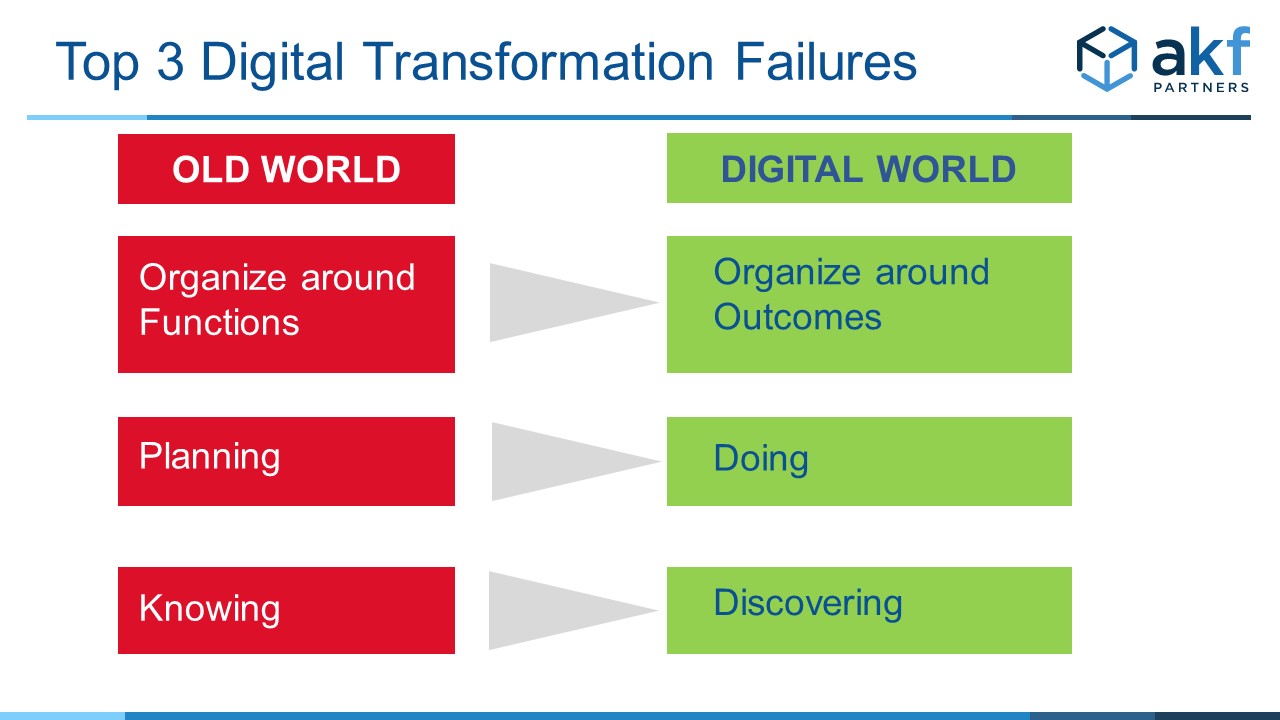Attempting to transform a company to compete effectively in the Digital Economy is difficult to say the least. In the experience of AKF Partners, it is easier to be “born digital” than to transform a successful, long tenured business, to compete effectively in the Digital age.
There is no single guaranteed fail-safe path to transformation. There are, however, 10 principles by which you should abide and 3 guaranteed paths to failure.
Avoid these 3 common mistakes at all costs or suffer a failed transformation.

Having the Wrong Team and the Wrong Structure
If you have a successful business, you very likely have a very bright and engaged team. But unless a good portion of your existing team has run a successful “born digital” business, or better yet transformed a business in the digital age, they don’t have the experience necessary to complete your transformation in the timeframe necessary for you to compete. If you needed lifesaving surgery, you wouldn’t bet your life on a doctor learning “on the job”. At the very least, you’d ensure that doctor was alongside a veteran and more than likely you would find a doctor with a successful track record of the surgery in question. You should take the same approach with your transformation.
This does not mean that you need to completely replace your team. Companies have been successful with organization strategies that include augmenting the current team with veterans. But you need new, experienced help, as employees on your team.
Further, to meet the need for speed of the new digital world, you need to think differently about how you organize. The best, fastest performing Digital teams organize themselves around the outcomes they hope to achieve, not the functions that they perform. High performing digital teams are
It also helps to hire a firm that has helped guide companies through a transformation. AKF Partners can help.
Planning Instead of Doing
The digital world is ever evolving. Plans that you make today will be incorrect within 6 months. In the digital world, no plan survives first contact with the enemy. In the old days of packaged software and brick and mortar retail, we had to put great effort into planning to reduce the risk associated with being incorrect after rather long lead times to project completion. In the new world, we can iterate nearly at the speed of thought. Whereas being incorrect in the old world may have meant project failure, in the new world we strive to be incorrect early such that we can iterate and make the final solution correct with respect to the needs of the market. Speed kills the enemy.
Eschew waterfall models, prescriptive financial models and static planning in favor of Agile methodologies, near term adaptive financial plans and OKRs. Spend 5 percent of your time planning and 95% of your time doing. While in the doing phase, learn to adapt quickly to failures and quickly adjust your approach to market feedback and available data.
The successful transformation starts with a compelling vision that is outcome based, followed by a clear near-term path of multiple small steps. The remainder of the path is unclear as we want the results of our first few steps to inform what we should do in the next iteration of steps to our final outcome. Transformation isn’t one large investment, but a series of small investments, each having a measurable return to the business.
Knowing Instead of Discovering
Few companies thrive by repeatedly being smarter than the market. In fact, the opposite is true – the Digital landscape is strewn with the corpses of companies whose hubris prevented them from developing the real time feedback mechanisms necessary to sense and respond to changing market dynamics. Yesterdays approaches to success at best have diminishing returns today and at worst put you at a competitive disadvantage.
Begin your journey as a campaign of exploration. You are finding the best path to success, and you will do it by ensuring that every solution you deploy is instrumented with sensors that help you identify the efficacy of the solution in real time. Real time data allows us to inductively identify patterns that form specific hypothesis. We then deductively test these hypotheses through comparatively low-cost solutions, the results of which help inform further induction. This circle of induction and deduction propels us through our journey to success.